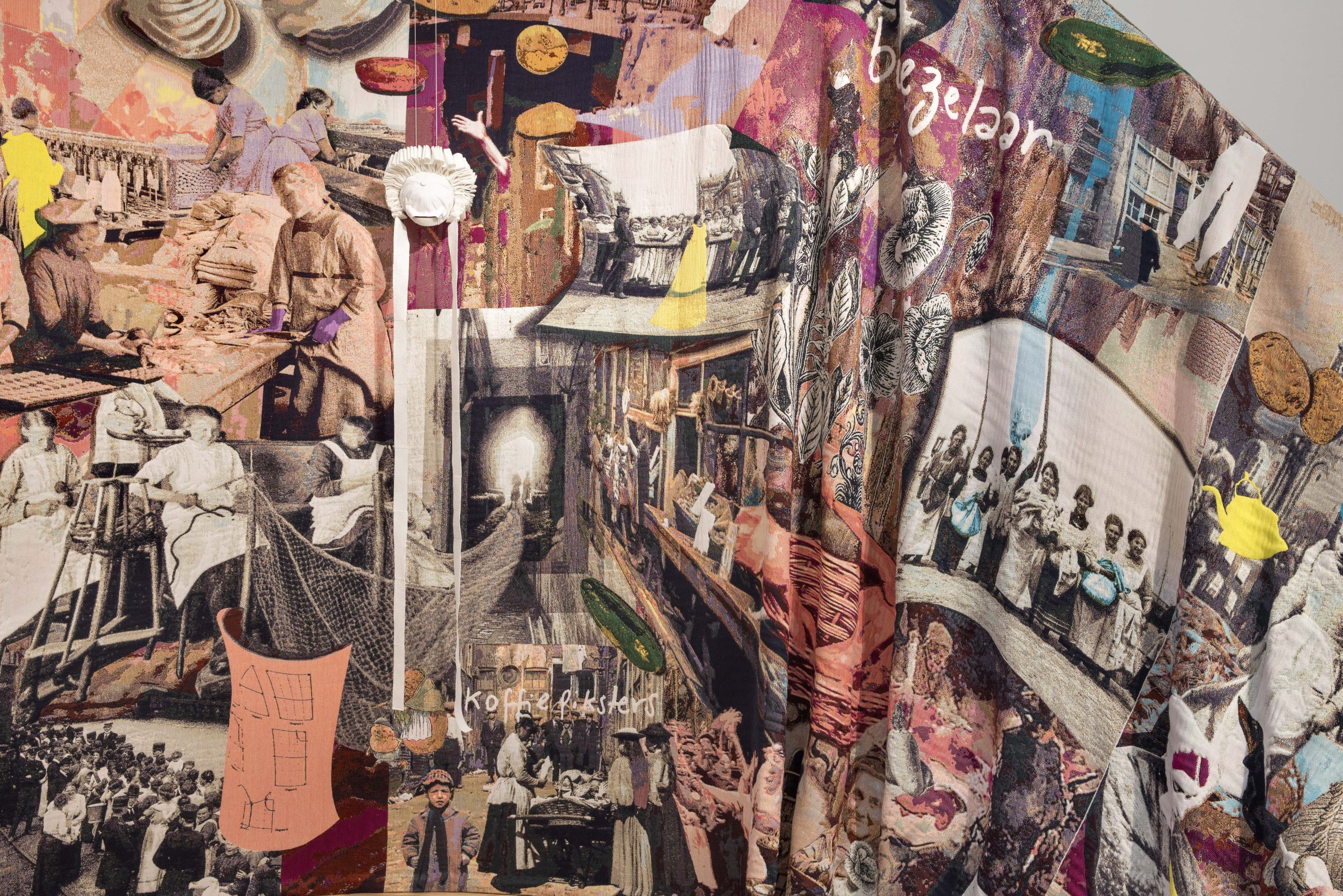Although the gigantic photo collage was too heavy to save as a single file, the resulting 12-metre-long tapestry rolled off the new Dornier loom in one piece. The imposing visual story Mercedes Azpilicueta designed for the Prix de Rome 2021 is on display in the Stedelijk Museum Amsterdam until 20 March.
In the installation in the Stedelijk Museum, ‘Potatoes, Riots and Other Imaginaries’ more closely resembles a sculpture than a tapestry. It winds gracefully around the viewer before casually sinking to the floor at what appears to be the end. In fact, this is the beginning: this is where four interwoven visual stories about the position of women through the ages start. The narrative begins around 1900, when women were dependent on cottage industries: we see them peeling onions and shrimps, shelling and cleaning beans. The next chapter zooms in on the 1917 Potato Riots in Amsterdam’s Jordaan district. Further along, we see the ‘factory girls’ who entered the labour force as industrialisation progressed.

Details tapestry ‘Potatoes, Riots and Other Imaginaries’.
Softening history
As the story unfolds, more and more connections are made between past and present, between Mercedes Azpilicueta’s personal experiences and the larger movements in women’s emancipation. Besides the Dutch factory girls, we also see Azpilicueta as a teenager on the catwalk in Argentina, promoting the collection in her mother’s clothing shop. At the end of the story, images of the Ni Una Menos protests in Buenos Aires refer back to the Potato Riots a century earlier in Amsterdam, where the Argentine artist has lived for five years. In the gigantic collage, historical archive images – from the TextielMuseum’s library, the National Archives and the Jordaan Museum – are interspersed with more recent photos from the artist’s own collection. “The past still resonates in everyday life,” Azpilicueta says. “We are constantly rewriting history. With this textile translation, which also contains personal memories, I’ve tried to embody and soften that history.”
Puzzle
Azpilicueta herself assumes various roles in the tapestry – as a protester, mother-to-be and professional maker in the TextielLab. She can be seen standing with product developer Judith Peskens behind the large Dornier loom on which her pièce de resistance was woven. Together, they selected 12 yarns for a palette that contains 125 colours. Peskens painstakingly translated the Photoshop files containing hundreds of images into maps/cards for the loom. “There are so many details and faces,” says Peskens. “You can go in so many directions with those colours: do you make light blue with blue and white, or do you add a little orange or green? I love figuring out that puzzle, especially when the result is as good as this. The next challenge was making the woven fabric as detailed as the photos, without the loom getting stuck on the colour changes. We achieved that too – with a lot of testing and adjusting pixels and weaves.” Adds Azpilicueta, “Fortunately, Judith has a keen eye for detail. She saw where things needed to be changed even before we started weaving.”
Details tapestry ‘Potatoes, Riots and Other Imaginaries’.
Letting go
Peskens continues: “Because Mercedes was heavily pregnant when the tapestry was made, she wasn’t in the lab every day. Now and then, I had a day to concentrate fully on working out the details. The nice thing about working with Mercedes is that she understands how long something like this takes. She is also able to let go of the original photo. We’re not making a print but a fabric. That adds a completely different dimension.” Both believe that translating the design into a textile has given it depth and brought it to life. “It was only when we laid out the woven cloth in the lab that we could see the scale of the whole piece,” Azpilicueta says. “It still surprised me.” Of the co-creation process that led to the end result, she says enthusiastically: “We’ve worked together before. Judith knows my work and knows what is important to me. She also really cares about what she makes, she feels connected to the work. That’s why I thought she deserved a place in it too.”